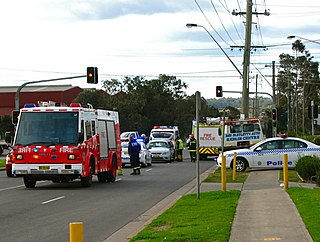
Civil defense or civil protection is an effort to protect the citizens of a state from human-made and natural disasters. It uses the principles of emergency operations: prevention, mitigation, preparation, response, or emergency evacuation and recovery. Programs of this sort were initially discussed at least as early as the 1920s and were implemented in some countries during the 1930s as the threat of war and aerial bombardment grew. Civil-defense structures became widespread after authorities recognised the threats posed by nuclear weapons.

The Federal Emergency Management Agency (FEMA) is an agency of the United States Department of Homeland Security (DHS), initially created under President Jimmy Carter by Presidential Reorganization Plan No. 3 of 1978 and implemented by two Executive Orders on April 1, 1979. The agency's primary purpose is to coordinate the response to a disaster that has occurred in the United States and that overwhelms the resources of local and state authorities. The governor of the state in which the disaster occurs must declare a state of emergency and formally request from the President that FEMA and the federal government respond to the disaster. The only exception to the state's gubernatorial declaration requirement occurs when an emergency or disaster takes place on federal property or to a federal asset—for example, the 1995 bombing of the Alfred P. Murrah Federal Building in Oklahoma City, Oklahoma, or the Space Shuttle Columbia in the 2003 return-flight disaster.

Emergency services and rescue services are organizations that ensure public safety, security, and health by addressing and resolving different emergencies. Some of these agencies exist solely for addressing certain types of emergencies, while others deal with ad hoc emergencies as part of their normal responsibilities. Many of these agencies engage in community awareness and prevention programs to help the public avoid, detect, and report emergencies effectively. Emergency services are often considered first responders, and typically have dedicated emergency vehicles.
An office of emergency management (OEM), alternatively called an emergency management office (EMO), or an emergency management agency (EMA) in some areas, is an agency at the local, tribal, state, federal, or international level that holds responsibility for comprehensively planning for and responding to and recovering from all manner of disasters, whether man-made or natural. An OEM may also be requested to provide consequence management for large special events such as major gatherings, visiting dignitaries, damage assessment following a disaster, etc.
The United States Computer Emergency Readiness Team (US-CERT) is an organization within the Department of Homeland Security’s (DHS) Cybersecurity and Infrastructure Security Agency (CISA). Specifically, US-CERT is a branch of the Office of Cybersecurity and Communications' (CS&C) National Cybersecurity and Communications Integration Center (NCCIC).

Emergency management or disaster management is the managerial function charged with creating the framework within which communities reduce vulnerability to hazards and cope with disasters. Emergency management, despite its name, does not actually focus on the management of emergencies, which can be understood as minor events with limited impacts and are managed through the day-to-day functions of a community. Instead, emergency management focuses on the management of disasters, which are events that produce more impacts than a community can handle on its own. The management of disasters tends to require some combination of activity from individuals and households, organizations, local, and/or higher levels of government. Although many different terminologies exist globally, the activities of emergency management can be generally categorized into preparedness, response, mitigation, and recovery, although other terms such as disaster risk reduction and prevention are also common. The outcome of emergency management is to prevent disasters and where this is not possible, to reduce their harmful impacts.

The National Disaster Medical System (NDMS) is a federally coordinated disaster medical system and partnership of the United States Departments of Health and Human Services (HHS), Homeland Security (DHS), Defense (DOD), and Veterans Affairs (VA). The purpose of the NDMS is to support State, local, Tribal and Territorial authorities following disasters and emergencies by supplementing health and medical systems and response capabilities. NDMS would also support the military and the Department of Veterans Affairs health care systems in caring for combat casualties, should requirements exceed their capacity. The NDMS was established in 1984.
The Florida Division of Emergency Management (DEM) is charged with maintaining a comprehensive statewide program of emergency management. The division ensures that Florida is prepared to respond to emergencies, recover from them, and mitigate their impacts. DEM is responsible for the State Emergency Response Team (SERT) which is composed of various intergovernmental entities, volunteers, and the private sector. The division coordinates the efforts of the Federal Government with other departments and agencies of state government, with county and municipal governments and school boards, and with private agencies that have a role in emergency management. The Director is appointed by the Governor of Florida, and serves as an agency head. Kevin Guthrie currently serves as the Director. He was appointed by Governor Ron DeSantis in May 2021.
In the United States, the hospital incident command system (HICS) is an incident command system (ICS) designed for hospitals and intended for use in both emergency and non-emergency situations. It provides hospitals of all sizes with tools needed to advance their emergency preparedness and response capability—both individually and as members of the broader response community.

The United States’ Emergency Management Institute (EMI), of the United States Federal Emergency Management Agency (FEMA), serves as the United States’ focal point for the development and delivery of emergency management training. The emergency management training improves the capabilities of state, territorial, local, and tribal government officials; volunteer organizations; FEMA's disaster workforce; other Federal agencies; and the public and private sectors to minimize the impact of disasters and emergencies on the American public. EMI curricula are structured to meet the needs of this diverse audience, with an emphasis on separate organizations working together in all-hazards emergencies to save lives and protect property. Particular emphasis is placed on governing doctrine, such as, the National Response Framework (NRF), National Incident Management System (NIMS), and the National Preparedness Guidelines. EMI is fully accredited by the International Association for Continuing Education and Training (IACET) and the American Council on Education (ACE). The instruction is based upon the principles of Emergency Management and instructional systems design. This instruction creates a framework within whole community to reduce vulnerability to hazards and to cope with disasters. EMI develops courses and implements training delivery systems to include residential onsite training; offsite delivery in partnership with Emergency Management training systems, colleges, and universities; and technology-based mediums to conduct individual training courses for Emergency Management and Response personnel across the United States.

Andrew Velasquez III is the former Regional Administrator for the U.S. Department of Homeland Security's Federal Emergency Management Agency (FEMA), Region V. He coordinated preparedness, response, recovery, and mitigation activities for the states of Illinois, Indiana, Michigan, Minnesota, Ohio, and Wisconsin. Prior to his appointment as Region V administrator he served as Director of the Illinois Emergency Management Agency and Executive Director of Chicago's Office of Emergency Management and Communication.
Maryland Department of Emergency Management (MDEM). is the department of the Maryland state government with primary responsibility and authority for emergency preparedness policy, and for coordinating hazard mitigation, incident response, and disaster recovery. It is headquartered in Reisterstown, Maryland.

The Oklahoma Department of Emergency Management (OEM) is a department of the government of Oklahoma responsible for coordinating the response to a natural disaster that has occurred in the State and that has overwhelmed the abilities of local authorities. This is achieved primarily through the development and maintenance of a comprehensive statewide emergency management plan. OEM is responsible for coordinating the efforts of the federal government with other state departments and agencies, county and municipal governments and school boards, and with private agencies that have a role in emergency management.
The California Governor's Office of Emergency Services is a California cabinet-level office responsible for overseeing and coordinating emergency preparedness, response, recovery and homeland security activities within the state. The agency was created by AB 38 (2008), superseding both the Office of Emergency Services (OES) and Office of Homeland Security (OHS).

The Adjutant General of Kansas is the highest-ranking military official in the State of Kansas and is subordinate to the Governor of Kansas. The Adjutant General is a member of the Governor's Cabinet and advises the Governor on military and emergency management matters. The Adjutant General runs the day-to-day administration of the Kansas Adjutant General's Department, including the Kansas National Guard.
The Stephenson Disaster Management Institute at Louisiana State University is located in the Stephenson National Center for Security Research and Training at LSU.

The Tennessee Emergency Management Agency (TEMA) is an agency of Tennessee government tasked with preparing for and responding to natural and man-made disasters across the state of Tennessee. The agency is headquartered in Nashville, Tennessee. TEMA is a component of the Tennessee Military Department, along with the Tennessee National Guard and the Tennessee State Guard.

The Minnesota Department of Public Safety (DPS) is a department of the State of Minnesota in the United States. DPS is an enforcement, licensing and services agency that develops and operates programs in the areas of law enforcement, traffic safety, alcohol and gambling, fire safety, driver licensing, vehicle registration, emergency management and public safety information. The department coordinates the functions and services of the state relating to the safety and convenience of its citizens.

Robert J. Fenton Jr is an American governmental official who worked for the Federal Emergency Management Agency (FEMA) in 1996 and was appointed Regional Administrator for FEMA Region IX: Arizona, California, Hawaii, Nevada, and the Pacific Islands in July 2015. He had a leadership role in the development of the National Incident Management System and the National Response Framework.

The Promoting Resilience and Efficiency in Preparing for Attacks and Responding to Emergencies Act, or PREPARE Act, of 2017 is a bill introduced in the United States House of Representatives by U.S. Representative Dan Donovan. The bill would assist American attempts to protect the nation from potential terror attacks and fortify emergency response capabilities through reauthorizing grants for programs that are necessary for disaster relief.












